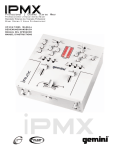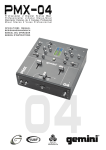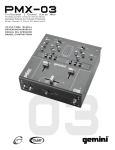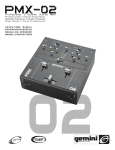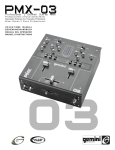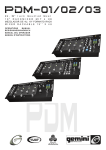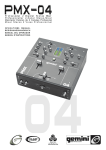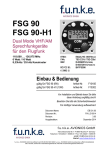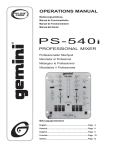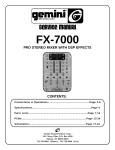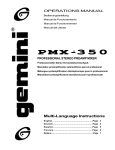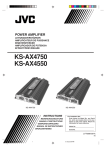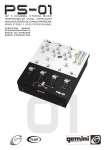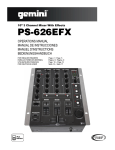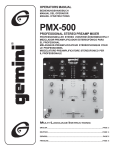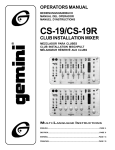Download 4U 19" Rack Mounted Club Mixer
Transcript
4U 19" Rack Mounted Club Mixer 19"- 4HE- CLUBMIXER FÜR RACKEINBAU MEZCLADOR CLUB DE 4U PARA MONTAR EN RACK 19" CONSOLE DE MIXAGE CLUB RACKABKE 19'' X 4U OPERATIONS MANUAL BEDIENUNGSHANDBUCH MANUAL DEL OPERADOR MANUEL D’INSTRUCTIONS MULTI LANGUAGE INSTRUCTIONS ENGLISH..............................................................................................................................................................................................................................................................................PAGE 4 DEUTSCH............................................................................................................................................................................................................................................................................PAGE 6 ESPAÑOL..........................................................................................................................................................................................................................................................................................................................................................................PAGE 8 FRANCAIS....................................................................................................................................................................................................................................................................................................................................................................PAGE 10 PLEASE READ BEFORE USING APPLIANCE, IMPORTANT WARNING & SAFETY INSTRUCTIONS! CAUTION RISK OF ELECTRICAL SHOCK DO NOT OPEN! CAUTION: This product satisfies FCC regulations when shielded cables and con nectors are used to connect the unit to other equipment. To prevent electromag netic interference with electric appliances such as radios and televisions, use shielded cables and connectors for connections. The exclamation point within an equilateral triangle is intended to alert the user to the presence of important operating and maintenance (servicing) instructions in the literature accompanying the appliance. The lightning flash with arrowhead symbol, within an equilateral triangle, is intended to alert the user to the presence of uninsulated “dangerous voltage” within the product’s enclosure that may be of sufficient magnitude to constitute a risk of electric shock to persons. READ INSTRUCTIONS: All the safety and operating instructions should be read before the product is operated. RETAIN INSTRUCTIONS: The safety and operating instructions should be retained for future reference. HEED WARNINGS: All warnings on the product and in the operating instructions should be adhered to. FOLLOW INSTRUCTIONS: All operating and use instructions should be followed. CLEANING: The product should be cleaned only with a polishing cloth or a soft dry cloth. Never clean with furniture wax, benzine, insecticides or other volatile liquids since they may corrode the cabinet. ATTACHMENTS: Do not use attachments not recommended by the product manu facturer as they may cause hazards. to provide some protection against voltage surges and built-up static charges. Article 810 of the National Electrical Code, ANSI/NFPA 70, provides information with regard to proper grounding of the mast and supporting structure, grounding of the lead-in wire to an antenna discharge unit, size of grounding conductors, loca tion of antenna-discharge unit, connection to grounding electrodes, and require ments for the grounding electrode. See Figure B. LIGHTNING: For added protection for this product during a lightning storm, or when it is left unattended and unused for long periods of time, unplug it from the wall out let and disconnect the antenna or cable system. This will prevent damage to the product due to lightning and power-line surges. POWER LINES: An outside antenna system should not be located in the vicinity of overhead power lines or other electric light or power circuits, or where it can fall into such power lines or circuits. When installing an outside antenna system, extreme care should be taken to keep from touching such power lines or circuits as contact with them might be fatal. OVERLOADING: Do not overload wall outlets, extension cords, or integral conven ience receptacles as this can result in a risk of fire or electric shock. OBJECT AND LIQUID ENTRY: Never push objects of any kind into this product through openings as they may touch dangerous voltage points or short-out parts that could result in a fire or electric shock. Never spill liquid of any kind on the product. SERVICING: Do not attempt to service this product yourself as opening or removing covers may expose you to dangerous voltage or other hazards. Refer all servicing to qualified service personnel. WATER AND MOISTURE: Do not use this product near water, for example, near a bathtub, wash bowl, kitchen sink, or laundry tub; in a wet basement; or near a swimming pool; and the like. DAMAGE REQUIRING SERVICE: Unplug this product from the wall outlet and refer servicing to qualified service personnel under the following conditions: ACCESSORIES: Do not place this product on an unstable cart, stand, tripod, brack et, or table. The product may fall, causing serious injury to a child or adult, and seri ous damage to the product. Use only with a cart, stand, tripod, bracket, or table recommended by the manufacturer, or sold with the product. Any mounting of the product should follow the manufacturer’s instructions, and should use a mounting accessory recommended by the manufacturer. • If liquid has been spilled, or objects have fallen into the product. • If the product has been exposed to rain or water. • If the product does not operate normally by following the operating instructions. Adjust only those controls that are covered by the operating instructions as an improper adjustment of other controls may result in damage and will often require extensive work by a qualified technician to restore the product to its normal oper ation. • If the product has been dropped or damaged in any way. • When the product exhibits a distinct change in performance, this indicates a need for service. CART: A product and cart combination should be moved with care. Quick stops, excessive force, and uneven surfaces may cause the product and cart combina tion to overturn. See Figure A. VENTILATION: Slots and openings in the cabinet are provided for ventilation and to ensure reliable operation of the product and to protect it from overheating, and these openings must not be blocked or covered. The openings should never be blocked by placing the product on a bed, sofa, rug, or other similar surface. This product should not be placed in a built-in installation such as a bookcase or rack unless proper ventilation is provided or the manufacturer’s instructions have been adhered to. POWER SOURCES: This product should be operated only from the type of power source indicated on the marking label. If you are not sure of the type of power sup ply to your home, consult your product dealer or local power company. LOCATION: The appliance should be installed in a stable location. NON-USE PERIODS: The power cord of the appliance should be unplugged from the outlet when left unused for a long period of time. • REPLACEMENT PARTS: When replacement parts are required, be sure the service technician has used replacement parts specified by the manufacturer or have the same characteristics as the original part. Unauthorized substitutions may result in fire, electric shock, or other hazards. SAFETY CHECK: Upon completion of any service or repairs to this product, ask the service technician to perform safety checks to determine that the product is in proper operating condition. WALL OR CEILING MOUNTING: The product should not be mounted to a wall or ceil ing. HEAT: The product should be situated away from heat sources such as radiators, heat registers, stoves, or other products (including amplifiers) that produce heat. GROUNDING OR POLARIZATION: • If this product is equipped with a polarized alternating current line plug (a plug having one blade wider than the other), it will fit into the outlet only one way. This is a safety feature. If you are unable to insert the plug fully into the outlet, try reversing the plug. If the plug should still fail to fit, contact your electrician to replace your obsolete outlet. Do not defeat the safety purpose of the polarized plug. • If this product is equipped with a three-wire grounding type plug, a plug having a third (grounding) pin, it will only fit into a grounding type power outlet. This is a safety feature. If you are unable to insert the plug into the outlet, contact your electrician to replace your obsolete outlet. Do not defeat the safety purpose of the grounding type plug. When the power-supply cord or plug is damaged. POWER-CORD PROTECTION: Power-supply cords should be routed so that they are not likely to be walked on or pinched by items placed upon or against them, paying particular attention to cords at plugs, convenience receptacles, and the point where they exit from the product. OUTDOOR ANTENNA GROUNDING: If an outside antenna or cable system is connected to the product, be sure the antenna or cable system is grounded so as (2) (3) INTRODUCTION: Congratulations on purchasing a Gemini MM-03 4U 19", 5 channel, rack mounted club mixer. This state of the art mixer is backed by a three year warranty, excluding crossfader and channel slides. The crossfader and channel slides are backed by a separate 90 day warranty. Prior to use we suggest that you carefully read all the instructions. FEATURES: - 4U 19" rack mounted club mixer - 5 stereo Channels - 8 line, 3 Mic, 2 convertible phono/line, RCA inputs - 3 band rotary line EQ control per channel with cut feature - Fully removable, user replaceable Rail Glide crossfader - Assignable cross fader - Rotary gain control per channel - Dual display with bright LED - Push-button cueing with cue/PGM fader control - Rotary master, zone, balance & cue volume controls - Master, zone & record RCA outputs - Balanced master output - XLR-1/4" combo Mic input - 2 band rotary Mic EQ control with cut feature - Rotary Mic volume control - Auto Talk-Over feature - Face plate located 1/4" headphone input CAUTIONS: 1. All operating instructions should be read before using this equipment. 2. To reduce the risk of electrical shock, do not open the unit. Please refer servicing to a qualified service technician. In the USA ~ if you experience problems with this unit call Gemini Customer Service at: 1 (732) 738-9003. Do not attempt to return this equipment to your dealer. 3. Do not expose this unit to direct sunlight or to a heat source such as a radiator or stove. 4. This unit should be cleaned only with a damp cloth. Avoid solvents or other cleaning detergents. 5. When moving this equipment, it should be placed in its original carton and packaging. This will reduce the risk of damage during transit. 6. DO NOT EXPOSE THIS UNIT TO RAIN OR MOISTURE. 7. DO NOT USE ANY SPRAY CLEANER OR LUBRICANT ON ANY CONTROLS OR SWITCHES. CONNECTIONS: 1. Before plugging the power cord in, make sure that the VOLTAGE SELECTOR (2) switch is set to the correct voltage (115 or 230). 2. Located on the rear panel is the 115/230V PLUG (1) used to plug in the power cord. Before plugging the power cord in to the 115/230V PLUG (1) and then into an electrical output, make sure the POWER SWITCH (70) located on the face panel is turned OFF. 3. The MM-03 has 4 sets of outputs: - The BALANCED MASTER (6) output jacks connectconnect the mixer to main amplifier using standard cables with 1/4" CONNECTORS. We recommend using balanced cables if the distance to your amp is 10 feet or more. - The MASTER (3) output jacks also connect to the main amplifier with RCA cables. -The ZONE (5) output jacks allow the connection of an additional amplifier with RCA cables. (4 4) - The REC (4) output jacks can be used to connect the mixer to the record input of your recording unit, thus enabling you to record your mix with RCA cables. 4. Located on the rear panel are 2 Phono(PH)/Line(LN) convertible RCA inputs (13, 16), and 6 line RCA inputs (7, 8, 9, 14, 17, 18). The convertible RCA inputs for CH 2 (38) & CH 3 (45) allow PH and LN level equipment to be connected to the mixer. To adjust the CONVERTER(S) (12, 15), just flip the switch UP to operate PH 1 or PH 2. Flip the switch DOWN to operate through LN 2 or LN 4. The PH INPUTS only accept turntables with a magnetic cartridge. When using (a) turntable(s), you will need to ground the RCA cable(s) by screwing in the grounding fork(s) to the GROUNDING SCREW (11) located in the back panel of the MM-03 mixer. This is located in between the CONVERTER SWITCHES (12, 15). The stereo LN INPUTS only accept line level inputs such as a CD, DAT, MiniDisc, etc. NOTE: NOT ATTACHING A GROUND MAY CAUSE A SYSTEM "HUM." 5. Headphones may be plugged into the face-plate located 1/4" HEADPHONE JACK (60). 6. The MIC 1 (20) input (located on the front panel) is a combination of an XLR and ¼" connector. The MIC 2 (19) and Mic 3 (10) inputs (in the rear panel) accept only 1/4" connectors. The mic inputs accept balanced and unbalanced microphones. OPERATIONS: 1. Once all of your connections have been in the rear panel, turn on the mixer by pressing the POWER SWITCH (70). 2. CHANNEL 1: To bring this channel in to program output (PGM), you must first decide which line will be in use. Use the LN SWITCH (25) to toggle from LN 1 (18) to MIC 2 (19) on this channel. Slowly raise the CH 1 SLIDE CONTROL (31) to a comfortable level, once you've selected the proper line. You can further modify the sound output of this channel by adjusting the rotary GAIN (26), HIGH (28), MID (29), LOW (30) controls located to the left of the CH 1 SLIDE CONTROL (31). 3. Channel 2: To bring this channel in to PGM, you must first decide which line will be in use. Use the LN SWITCH (32) to toggle from PH1/LN 2 (16) to LN 3 (17) on this channel. Slowly raise the CH 2 SLIDE CONTROL (38) to a comfortable level, once you've selected the proper line. You can further modify the sound output of this channel by adjusting the rotary GAIN (33), HIGH (35), MID (36), LOW (37) controls located to the left of the CH 2 SLIDE CONTROL (38). 4. CHANNEL 3: To bring this channel in to PGM, you must first decide which line will be in use. Use the LN SWITCH (39) to toggle from PN2/LN4 (13) to LN 5 (14) on this channel. Slowly raise the CH 3 SLIDE CONTROL (45) to a comfortable level, once you've selected the proper line. You can further modify the sound output of this channel by adjusting the rotary GAIN (40), HIGH (42), MID (43), LOW (44) controls located to the left of the CH 3 SLIDE CONTROL (45). 5. CHANNEL 4: To bring this channel in to PGM, you must first decide which line will be in use. Use the LN SWITCH (46) to toggle from LN 6 (9) to MIC 3 (10) on this channel. Slowly raise the CH 4 SLIDE CONTROL(52) to a comfortable level, once you've selected the proper line. You can further modify the sound output of this channel by adjusting the rotary GAIN (47), HIGH (49), MID (50), LOW (51) controls located to the left of the CH 4 SLIDE CONTROL (52). 6. CHANNEL 5: To bring this channel in to PGM, you must first decide which line will be in use. Use the LN SWITCH (53) to toggle from LN 7 (8) to LN 8 (7) on this channel. Slowly raise the CH 5 SLIDE CONTROL (59) to a comfortable level, once you've selected the proper line. You 10. OUTPUT SELECTION CONTROL: Once you are comfortable with the sound level of your music you may adjust the volume with the MASTER (64) rotary control. You may adjust the volume of the zone output with the ZONE (66) rotary control. You may also adjust the balance from left to right with the BALANCED MASTER (63) rotary control. 11. MIC SECTION: Plug your main mic into the MIC 1 combination XLR-1/4" input (20) located on the face panel. The rotary controls for HIGH (22) and LOW (23) for MIC 1 (20) allow you to adjust the tone of MIC 1 (20). The MIC 1 rotary volume control (21), above the HIGH(22)/LOW(23) controls, adjust the decibel level of MIC 1 (20). You may also plug a second and third mic into the rear panel's MIC 2 (19) and MIC 3 (10) ¼" jacks. The tone and decibel level of MIC 2 (19) and MIC 3 (10) are controlled by the CH 1 (31) and CH 4 (52) slide controls, the 3 BAND ROTARY EQ (HIGH (28, 49), MID (29, 50), LOW (30, 51)) controls and GAIN (26, 47) rotary controls, respectively. 12. TALKOVER: The purpose of the AUTO TALKOVER MODE is to allow the program playing to be muted so that the mic may be heard above the music. The MIC/TALKOVER SWITCH (24) controls MIC 1 (20) with 3 settings: - When the MIC/TALKOVER SWITCH (24) is in the BOTTOM position, MIC 1 (20) and TALKOVER MODE are all OFF. - When the MIC/TALKOVER SWITCH (24) is in the CENTER position, MIC 1 (20) is ONand TALKOVER MODE is OFF. The MIC ON LED INDICATOR glows when MIC 1 (20) is ON. - When the MIC/TALKOVER SWITCH (24) is in the TOP position, MIC 1 (20) is ON and TALKOVER MODE is ON, and the volume of all sources except MIC 1(20) inputs is lowered by -16 dB. 13. VU METER: The VU METER (65) indicates the program output level of the MASTER (3) left and right stereo levels. can further modify the sound output of this channel by adjusting the rotary GAIN (54), HIGH (56), MID (57), LOW (58) controls located to the left of the CH 5 SLIDE CONTROL (59). NOTE: FOR OPTIMAL PERFORMANCE, BEGIN PROGRAM MIX WITH ROTARY GAIN (26, 33, 40, 47, 54) CONTROLS SET TO ZERO (ROTATE IT COUNTERCLOCKWISE TO THE LEFT POSITION). MAKE ALL ADJUSTMENTS IN SOUND OUTPUT WITH THE USE OF YOUR CHANNEL SLIDE CONTROLS (31, 45, 59, 38, 52), ZONE (66), BALANCED MASTER (63), AND MASTER (64) VOLUME ROTARY CONTROLS. THIS WILL PREVENT SIGNAL OVERLOAD AND DECREASE DISTORTION. ONCE YOU HAVE MODIFIED YOUR SOUND AND WOULD LIKE TO INCREASE THE OUTPUT OF YOUR SOUND, THEN YOU MAY ADJUST THE ROTARY GAIN CONTROL IF NEEDED. 7. CUE: By connecting a set of headphones to the HEADPHONE (60) jack, you can monitor any or all channels. Press CUE buttons (27, 34, 41, 48, 55) for CH 1 through CH 5 to assign the Channel(s) to be monitored. The respective CUE LED indicators will glow when in use. Use the rotary CUE VOLUME CONTROL (61) to adjust the cue volume without changing the overall mix. By moving the CUE/PGM FADER CONTROL (62) to the LEFT you will be able to monitor the assigned cue signal. Moving the control to the RIGHT allows you to monitor PGM output. Moving the control to the MIDDLE allows cue mix with PGM. 8. ASSIGN: There are 2 ROTARY CONTROLLED ASSIGN SWITCHES (67, 68), each having 5 settings 1, 2, 3, 4 and 5. The LEFT ASSIGN (67) control allows you to direct CH 1, 2, 3, 4 or 5 through the LEFT side of the CROSSFADER (69). The RIGHT ASSIGN (68) control allows you to direct CH 1, 2, 3, 4 or 5 through the RIGHT side of the CROSSFADER (69). 9. CROSSFADER SECTION: The CROSSFADER (69) allows you to mix from one source to another. The MM-03 features an ASSIGNABLE CROSSFADER (69). The rotary controlled ASSIGN SWITCHES (67, 68) allow you to select which channel will play through each side of the CROSSFADER (69). The CROSSFADER (69) in your unit is removable and if the need arises can be easily replaced. Your Gemini mixer comes with an RG-45 (RAILGLIDE™) Dual-Rail Crossfader. Rail Glide™ crossfaders have internal dual stainless steel rails that allow the slider to ride smoothly and accurately from end to end. Also available is our RG-45 PRO (PROGLIDE™) Dual-Rail Crossfader. This unique crossfader features, a special curve designed for scratch mixing. Just purchase one from your Gemini dealer and follow the instructions: Replaceable Crossfader 1. Unscrew the outside FADER plate screws (B). - Do not touch INSIDE SCREWS (C). 2. Carefully remove old Crossfader and unplug CABLE (D). 3.Plug new Crossfader into CABLE (D) and place back into mixer. 4. Screw Crossfader to mixer with the FADER PLATE SCREWS (B). SPECIFICATIONS: INPUTS: Phono............................................................3 mV, 47 KOhm Line...........................................................150 mV, 27 KOhm MIC 1, MIC 2, & MIC 3.................1.5 mV, 1 K Ohm Balanced MIC 1 Bass.................................................................± 12dB MIC 1 High..................................................................± 12dB OUTPUTS: Amp/Zone.................................................0 dB 1V, 400 Ohm Max...........................................................20V Peak-to-Peak Rec..............................................................225 mV, 5 KOhm GENERAL: Frequency Response..........................20Hz - 20KHz +/- 2 dB Distortion...................................................................< 0.02% S/N Ratio...................................................Better Than 80 dB Talkover Attenuation....................................................-16 dB Headphone Impedance.............................................16 Ohm Power Source.................................115/230V, 50/60Hz, 20W Unit Dimensions..................................W 19" x H 4" x D 7.42" ....................................................(482.6 x 101.6 x 188.6 mm) Weight.........................................................8.84 lbs (4.01kg) SPECIFICATIONS SUBJECT TO CHANGE WITHOUT NOTIFICATION FOR IMPROVEMENT. (5) EINLEITUNG: Wir gratulieren Ihnen zum Kauf eines Gemini MM-03 19"- 4HE- Clubmixer für Rackeinbau. Auf dieses moderne Mischpult gewähren wir eine dreijährige Garantie, ausschließlich Crossfader. Vor Anwendung dieses Mischpults bitte alle Anweisungen sorgfältig durchlesen. FUNKTIONEN: - 19"- 4HE- clubmixer für rackeinbau - 5 stereo kanäle - 8 line, 3 Mikro, 2 umschaltbare phono/line, cincheingänge - 3 band EQ mit drehreglern und cut funktion pro kanal - Einfach auszutauschender RailGlide-crossfader - Zuweisbarer crossfader - Gaindrehregler pro kanal - Zweifach modeanzeige mit heller LED - Cuesektion mit drucktastern und cue/PGM fader - Drehregler für master, zone, balance und cue - Master, zone und record cinchausgänge - Symmetrischer masterausgang - Mikrofoneingang mit kombibuchse XLR/Klinke - 2 band Mic Eq mit drehreglern - Drehregler für mikrofonlautstärke und cut funktion - Talk-Over funktion - 6,3mm Kopfhörerklinkenbuchse auf der frontplatte anzuschließen um die Tonmischung aufnehmen zu können. 4. An der Rückseite sind jeweils 2 Stereoeingänge PHONO/LINE (13, 16) und 6 Stereoeingänge LINE (18, 17, 14, 9, 8, 7)) angebracht. Die Schalter PHONO/LINE (12, 15) ermöglichen Ihnen, die Eingänge (38, 45) zwischen PHONO und LINE umzuschalten. An die PhonoEingänge können nur Plattenspieler mit einem magnetischem Tonabnehmer angeschlossen werden. Zwei Erdungschrauben GROUND SCREW (11) zur Erdung des Plattenspielers sind an der Rückseite angebracht. An die Stereo-Lineeingänge können Geräte wie CD- oder Kassettenspieler angeschlossen werden. Anmerkung: Wenn die Erdung nicht angeschlossen wird kann ein Brummsignal auftreten. 5. Kopfhörer können an der an der Vorderwand montierten Kopfhörer-Buchse HEADPHONE (60) eingesteckt werden. 6. Der Eingang MIC 1 (20) (an der Vorderseite) ist als Klinke/XLR-Kombibuchse ausgeführt. Die Eingänge MIC 2 (19) und Mic 3 (10) (Rückseite) haben je eine 6,3mm Klinkenbuchse. Alle sind für symmetrische und unsymmetrische Mikrophone geeignet. BEDIENUNG: VORSICHTSMAßNAHMEN: 1. Vor Anwendung dieses Geräts bitte alle Anweisungen sorgfältig durchlesen. 2. Das Gerät nicht öffnen, um das Risiko eines elektrischen Schocks zu vermeiden. Die Wartung darf nur von befähigten Wartungstechnikern durchgeführt werden. 3. Das Gerät nicht direktem Sonnenlicht oder einer Wärmequelle wie Heizkörper oder Ofen aussetzen. 4. Dieses Gerät darf nur mit einem feuchten Tuch gesäubert werden. Keine Lösungs- oder Reinigungsmittel benutzen. 5. Bei Umzügen sollte das Gerät in seinem ursprünglichen Versandkarton und Verpackungsmaterial verpackt werden. Dadurch verhindert man, daß das Gerät während des ransportes beschädigt wird. 6.DIESES GERÄT NICHT REGEN ODER FEUCHTIGKEIT AUSSETZEN. 7. AN DEN REGLERN ODER SCHALTERN KEIN SPRAYREINIGUNGSMITTEL ODER SCHMIERMITTEL BENUTZEN. ANSCHLÜSSE: 1. Bevor Sie das Stromkabel anschließen, darauf achten, daß der VOLTAGE SELECTOR (2) (Spannungswähler) auf die richtige Spannung einstellt ist und der ON/OFFSchalter aus ist. 2. Vor dem Einstecken des 115V/230 PLUG (1) in die Buchse: POWER (70) auf Rückseite, überprüfen Sie, ob der 115V/230V PLUG (1) Schalter ausgeschaltet ist. 3. Der MM-03 verfügt über 4 Ausgangsbuchsenpaare: - Die Buchsen BALANCED MASTER OUTPUT (6) sind symmetrische Klinkenbuchsen und dienen zum Anschluß an den Hauptverstärker (lange Kabel). - Die Buchsen MASTER OUTPUT (3) sind unsymmetrisch und dienen zum Anschluß an den Hauptverstärker (kurze Kabel). - Die Buchsen ZONE OUTPUT (5) ermöglichen den Anschluß an einen zusätzlichen Verstärker. - Die Buchsen REC OUTPUT (4) können dazu dienen, das Mischpult an den Aufnahmeeingang des Aufnahmegerätes (6) 1. STROM EIN: Nachdem Sie die Tonquellen und Ihren Verstärker am Mischpult angeschlossen haben, drücken Sie auf die Taste POWER (70). Der Strom wird eingeschaltet und die VU METER (65) leuchten. 2. KANAL 1: Schalter (25) ermöglicht, den Eingang von LN 1 (18) oder MIC 2 (19) auszuwählen. Der Kanalfader CHANNEL SLIDE (31) regelt das Ausgangssignal dieses Kanals. 3. KANAL 2: Schalter (32) ermöglicht, den Eingang von PH1/LN2(16) oder LN3 (17) auszuwählen. Der Kanalfader CHANNEL SLIDE (38) regelt das Ausgangssignal dieses Kanals. 4. KANAL 3: Schalter (39) ermöglicht, den Eingang von PH2/LN4 (13) oder LN5 (14) auszuwählen. Der Kanalfader CHANNEL SLIDE (45) regelt das Ausgangssignal dieses Kanals. 5. KANAL 4: Schalter (46) ermöglicht, den Eingang von LN 6 (9) oder Mic 3 (10) auszuwählen. Der Kanalfader CHANNEL SLIDE (52) regelt den Ausgangstonsignal dieses Kanals. 6. KANAL 5: Schalter (53) ermöglicht, den Eingang von LN 7 (8) auf LN8 (7) umzuschalten. Der Kanalfader Channel Slide (59) regelt das Ausgangssignal dieses Kanals. Der Eingangspegel der einzelnen Kanäle wird mit den Gaindrehreglern eingestellt. Die Klangregelung erfolgt mit den Drehreglern High, Mid, Low des jeweiligen Kanals. 7.AUSGANGSREGELUNG: Der Verstärkerausgangspegel MASTER OUTPUT (3) wird vom Drehregler MASTER (64) geregelt. Die BALANCE (63)(L/R) wird mit dem Drehregler BALANCE eingestellt. Der Zoneausgang wird mit dem Drehregler ZONE (66) geregelt 8. CUE: Indem Sie die Kopfhörer an der Buchse KOPFHöRER (60) anschließen, können Sie einen oder alle Kanäle kontrollieren. Drücken Sie die Tasten CUE ASSIGN (27, 34 , 41, 48, 55) für Kanäle 1-5, um den/die zu kontrollierende/n Kanal/Kanäle auszuwählen, und deren jeweilige LED-Anzeigen werden aufleuchten. Betätigen Sie den CUE Volumedrehregler (61), um die Mithörlautstärke einzustellen, ohne dabei die allgemeine Mischung zu beeinträchtigen. Indem Sie den Regler CUE PGM PAN (62) nach LINKS schieben, können Sie das zugewiesene Mithörsignal kontrollieren. Nach RECHTS schieben wird die PGM-Programm Ausgabe kontrolliert. 9. Der ASSIGN (67)-Schalter hat 5 Einstellungen (1, 2, 3, 4 oder 5) und ermöglicht Ihnen, Kanäle 1, 2, 3, 4 oder 5 durch die linke Seite des Überblenders zu spielen. Der ASSIGN (68)-Schalter hat 5 Einstellungen (1, 2, 3, 4 oder 5) und ermöglicht Ihnen, Kanäle 1, 2, 3, 4 oder 5 durch die rechte Seite des Überblenders zu spielen. 10. ÜBERBLENDER-BEREICH: Der Überblender CROSSFADER (69) ermöglicht das Mischen von Tonquellen. Der MM-03 bietet einen zuweisbaren Crossfader. Die ASSIGN (67, 68)-Schalter ermöglichen Ihnen den Kanal auszuwählen, der durch jeweilige Seite des Überblenders geregelt wird. Der CROSSFADER (69) Ihres Geräts kann entfernt werden und läßt sich bei Bedarf leicht ersetzen. Überblender sind in zwei Ausführungen verfügbar. Der RG-45 (RAIL GLIDE) DualRail Crossfader. Die Rail Glide™ Überblender enthalten innere Schienen aus rostfreiem Stahl, die dem Benutzer ermöglichen, den Überblender sanft und genau von der einen zur anderen Seite zu schieben. Auch ist unser RG-45 PRO (PROGLIDE™) Dual-Rail Crossfader vorhanden. Dieses einzigartige Überblender hat folgende Eigenschaften: ultraleichtes Gleiten durch Edelstahlschienen und sehr lange Lebensdauer, durch neueste Leitplastiktechnologie. Sie können einen dieser Überblender bei Ihrem Gemini-Händler beziehen und diese Anweisungen befolgen: EINFACH AUSZUTAUSCHENDER RAIL-GLIDECROSSFADER - Die äußeren SCHRAUBEN DER CROSSFADERPLATTE (B) losschrauben. Nicht die INNENSCHRAUBEN (C) losschrauben. - Den Überblender vorsichtig anheben und das KABEL (D) abziehen. - Das Kabel auf den neuen Fader stecken und wieder in das Mischpult setzen. - Den neuen Crossfader mit den Schrauben am Mischpult befestigen. Klang von MIC 1 (20) zu regulieren. MIC 1 LEVEL (21) reg-uliert den Pegel von MIC 1 (20). Zusätzlich können sie zweit weitere Mikrofone an die MIC 2 (19) und Mic 3 (10) Klinkenbuchsen (19 und 10) (Rückseite) anschließen. Die Pegel und den Klang regeln Sie mit dem Kanal 1 (Mic 2) und dem Kanal 4 (Mic 3). 12. TALKOVER: Durch die TALKOVER-FUNKTION wird das abgespielte Programm gedämpft, um eine Ansage über das Mikrophon hören zu können. Der Schalter MIC/TALKOVER (24) kontrolliert MIC 1 (20) mit drei Einstellungen: - Wenn der Schalter MIC/TALKOVER (24) in der UNTEREN position steht, sind MIC 1 und TALKOVER AUSGESCHALTET. - Steht der Schalter MIC/TALKOVER (24) in der MITTLEREN position, ist MIC 1 (20), EINGESCHALTET. Der MIC-Anzeiger (24) ist erleuchtet, jedoch ist TALKOVER AUSGESCHALTET. - Wenn der Schalter MIC/TALKOVER (24) in der OBEREN position steht, sind MIC 1 (20), und TALKOVER EINGESCHALTET und Lautstärken aller Tonquellen, außer der MIC-Eingänge, werden um -16 dB reduziert. 13. VU Meter: Das VU Meter (65) zeigt den linken und rechten Ausgangspegel des MASTER OUTPUT (3) an. SPEZIFIKATIONEN: EINGÄNGE: Phono:.........................................................3 mV, 47 KOhm Line:.........................................................150 mV, 27 KOhm MIC 1, 2, 3:..........................1.5 mV, 1 K Ohm symmetrisch Bass:.........................................................................± 12dB High:..........................................................................± 12dB OUTPUTS: Verstärker/Zone:......................................0 dB 1V, 400 Ohm Max:..........................................................20V Spitze-Spitze Rec:...........................................................225 mV, 5 KOhm TECHNISCHE DATEN: Frequenzbereich:.............................20Hz - 20KHz +/- 2 dB Klirrfaktor:..................................................kleiner als 0.02% Geräuschspannungsabstand:....................Besser als 80 dB Talkover Dämpfung:...................................................-16 dB Kopfhörer Impedanz:...............................................16 Ohm Spannungsversorgung:.................115/230V, 50/60Hz, 20W Abmessungen:............................482.6 x 101.6 x 188.6 mm Gewicht:....................................................................4.01 kg 11.MIKROFONSEKTION: Schließen Sie Ihr Hauptmikrofon an die MIC 1 XLR-Buchse (20) auf der Frontplatte an. Die Regler HIGH (22) und LOW (23) ermöglichen Ihnen, den (7 7) DIE SPEZIFIKATIONEN KÖNNEN ZU VERBESSERUNGSZWECKEN OHNE VORHERIGE BEKANNTGABE GEÄN DERT WERDEN. INTRODUCCIÓN: Felicitaciones por la compra del Mezclador Club MM-03 de 4U para montar en rack 19" de Gemini. Este mezclador de la más avanzada tecnología está respaldado por una garantía de tres años, salvo el crossfader y los faders. Antes de usarlo, le recomendamos leer cuidadosamente todas las instrucciones. CARACTERÍSTICAS: - Mezclador cClub de 4U para montar en rack 19" - 5 canales estéreo - Entradas RCA para 8 línea, 3 Micro, 2 convertible phono/línea - EQ rotativo de 3 bandas por canal con sistema cut - Crossfader Rail Guide removible, para ser reemplazado por el usuario - Cross Fader asignable - Ganacia rotativa por canal - Doble display de modo con LED - Interruptor para cue/PGM - Control de volumen rotativo para master, zone, balance y cue - Salida RCA para master, zona y grabación - Salida balanceada de master - Entrada XLR-1/4" combo para Micro - EQ de 2 bandas para Micro con sistema cut - Talk-Over - Entrada para auriculares 1/4" en la parte superior PRECAUCIONES: 1. Deberán leerse todas las instrucciones de operación antes de usar el equipo. 2. Para reducir el riesgo de shock eléctrico, no abra esta unidad. Por favor, refiera el servicio a un técnico de servicio calificado. En los EE.UU., si Ud tiene problemas con el aparato, por favor llame al Servicio Post-Venta al 1-732-738-9003. No devuelva el aparato a la tienda donde lo compró. 3. No exponga la unidad a la luz solar directa ni a una fuente de calor, por ejemplo, un radiador o estufa. 4. Esta unidad sólo deberá limpiarse con un paño húmedo. Evite el uso de disolventes u otros detergentes de limpieza. 5. Para mover este equipo, colóquelo en la caja y embalaje original, a fin de reducir el riesgo de daños durante el transporte. 6. NO DEJE ESTA UNIDAD EXPUESTA A LLUVIA O HUMEDAD. 7. NO USE LIMPIADORES DE ROCÍO O LUBRICANTES EN LOS CONTROLES O INTERRUPTORES. CONEXIONES: 1. Antes de conectar el cable de potencia, cerciórese de que el SELECTOR DE VOLTAJE (2) esté posicionado en la tensión correcta. 2. Ubicado en la parte trasera está la toma de CORRIENTE (1). Antes de conectar el cable de CORRIENTE (1), asegurarse que el BOTON DE ENCENDIDO (70) en el panel frontal está apagado. 3. El MM-03 tiene 4 salidas: - SALIDA MASTER BALANCEADA (6) conectan el mezclador al amplificador principal usando cables standar con conectores Jack 1/4". Se recomienda usar cables balanceados si la distancia al amplificador es mayor de 3 metros. - SALIDA MASTER (3) también conecta el mezclador con el amplificador principal, pero con conectores RCA. - SALIDA ZONA (5) permite la conexión a un amplificador adicional con conexión RCA. - SALIDA DE GRABACIÓN (4) puede ser utilizada para conectar con cables RCA el mezclador a una entrada de un dsipositivo de grabación , así como permitir grabar tu propia sesión. 4. En el panel trasero hay 2 entradas RCA estereofónicas convertibles PHONO/LÍNEA - PHONO/LINE (13,16), y 6 entradas RCA estereofónicas de LÍNEA - LINE (7,8,9,14,17,18). (8) Las entradas convertibles RCA de los canales (CN) 2 (38) y 3 (45) permiten conectar el nivel Phono (PH) y Línea (LN) al mezclador. Para ajustar los CONVERTIDORES (12,15), sólo seleccionar PH1 o PH2 hacia arriba en el interruptor. Seleccionar hacia abajo para LN2 o LN4. Las entradas PH sólo aceptan giradiscos con cápsula magnética. Cuando se use giradiscos, es necesario enroscar la masa de los cables RCA en losTERMINALES de MASA (11) traseros. Estan ubicados entre los interruptores de CONVERSIÓN (12,15). Las ENTRADAS LN ESTÉREO sólo aceptan niveles de señal de entrada de tipo CD, DAT, MiniDisc, etc. NOTA: AL NO CONECTAR UNA MASA PUEDE CAUSAR RUIDOS. 5. Los auriculares se enchufan en el jack de HEADPHONES (60) (auriculares) montado en el panel delantero. 6. La entrada MIC 1 (20) (que se encuentra en el panel delantero) acepta conector de XLR. La entrada MIC 2 (19) y MIC 3 (10) (que se encuentra en el panel trasero) acepta conector Jack de 1/4". Todas aceptans micrófonos balanceados y no balanceados. FUNCIONES: 1. ENCENDIDO: Una vez que se hayan efectuado todas las conexiones de los equipos a su mezclador, encienda el mezclador pulsando el interruptor de encendido POWER SWITCH (70). 2. CANAL 1: Para pasar este canal a program (PGM), primero debe decidir qué línea estará en uso. Utilizar el interruptor LN (25) para seleccionar la palanca de LN1 (18) a MIC2 (19) en este canal. Una vez se haya seleccionado la entrada apropiada, deslizar suavemente el fader del CN 1 ( 31) hasta un nivel adecuado, una vez se haya seleccionado la entrada apropiada. A más a más se puede modificar el nivel de salida de este canal ajustando el control rotativo de GAIN - GANANCIA (26), HIGHAGUDOS (28), MID-MEDIOS (29), LOW-GRAVES (30) ubicado encima del control de Fader del CN 1 (31). 3. CANAL 2: Para pasar este canal a program (PGM), primero debe decidir qué línea estará en uso. Utilizar el interruptor LN (32) para seleccionar la palanca de PH1/LN2 (16) a LN3 (17) en este canal. Una vez se haya seleccionado la entrada apropiada, deslizar suavemente el fader del CN 2 ( 38) hasta un nivel adecuado, una vez se haya seleccionado la entrada apropiada. A más a más se puede modificar el nivel de salida de este canal ajustando el control rotativo de GAIN - GANANCIA (33), HIGH-AGUDOS (35), MID-MEDIOS (36), LOW-GRAVES (37) ubicado encima del control de Fader del CN 2 (38). 4. CANAL 3: Para pasar este canal a program (PGM), primero debe decidir qué línea estará en uso. Utilizar el interruptor LN (39) para seleccionar la palanca de PH2/LN4 (13) a LN5 (14) en este canal. Una vez se haya seleccionado la entrada apropiada, deslizar suavemente el fader del CN 3 ( 45) hasta un nivel adecuado, una vez se haya seleccionado la entrada apropiada. A más a más se puede modificar el nivel de salida de este canal ajustando el control rotativo de GAIN - GANANCIA (40), HIGH-AGUDOS (42), MID-MEDIOS (43), LOW-GRAVES (44) ubicado encima del control de Fader del CN 3 (45). 5. CANAL 4: Para pasar este canal a program (PGM), primero debe decidir qué línea estará en uso. Utilizar el interruptor LN (46) para seleccionar la palanca de LN6 (9) a MIC 3 (10) en este canal. Una vez se haya seleccionado la entrada apropiada, deslizar suavemente el fader del CN 4 (52) hasta un nivel adecuado, una vez se haya seleccionado la entrada apropiada. A más a más se puede modificar el nivel de salida de este canal ajustan do el control rotativo de GAIN - GANANCIA (47), HIGHAGUDOS (49), MID-MEDIOS (50), LOW-GRAVES (51) ubicado encima del control de Fader del CN 4 (52). 6. CANAL 5: Para pasar este canal a program (PGM), primero debe decidir qué línea estará en uso. Utilizar el interruptor LN (53) para seleccionar la palanca de LN7 (8) a LN8 (7) en este canal. Una vez se haya seleccionado la entrada apropiada, deslizar suavemente el fader del CN 5 (59) hasta un nivel adecuado, una vez se haya seleccionado la entrada apropiada. A más a más se puede modificar el nivel de salida de este canal ajustando el control rotativo de GAIN - GANANCIA (54), HIGH-AGUDOS (56), MID-MEDIOS (57), LOW-GRAVES (58) ubicado encima del control de Fader del CN 5 (59). 7. CUE: Conectando los auriculares a la toma jack de HEADPHONE (60), podrá monitorizar cualquier canal o todos los canales. Pulsar los botones CUE (27,34,41,48,55) para los canales 1-5 para seleccionar el canal o los canales a monitorizar.Sus indicadores LED respectivos se iluminarán cunado sean pulsados tales botones. Use el control rotatorio de CUE (61) para ajustar el volumen de cue sin afectar la mezcla global. Moviendo el control deslizante CUE/PGM (62) hacia la IZQUIERDA podrá monitorizar la señal cue asignada. Moviéndolo hacia la DERECHA podrá monitorizar la salida de programa. Dejándolo en medio le permite escuchar la mezcla. 8. ASSIGN: Hay 2 controles de ASIGANCIÓN (67,68), cada uno tiene 5 preselecciones 1,2,3,4 y 5. El control izquierdo (67) permite seleccionar el CN 1,2,3,4 o 5 a través de la parte IZQUIERDA (69) del CROSSFADER. El control de asignación de la parte DERECHA (68) permite seleccionar el CN 1,2,3,4 o 5 a través de la parte DERECHA (69) del crossfader. 9. SECCIÓN CROSSFADER: El CROSSFADER (69) le permite mezclar de un canal a otro. Este modelo de mezclador incorporan selectores de asignación de crossfader (67, 68). Los selectores de asignación (67,68) permiten seleccionar qué canal quedará seleccionado para su uso en el CROSSFADER (69). El CROSSFADER (69) es fácilmente reemplazable. Este mezclador GEMINI viene con un RG-45 PRO (RAILGLIDE™) Crossfader de Doble Rail . Rail Glide™crossfaders tienen internamente dos railes de acero inoxidable que permiten al crossfader desplazarse preciso y suavemente de un extremo a otro. Otro crossfader disponible es el PSF-45 (PRO SCRATCH™) con una curva de crossfader especial diseñada para mezcla tipo scratch. Sólo comprar uno en cualquier distribuidor Gemini y siga las instrucciones: 10. CONTROL DE LA SALIDA: Una vez se haya regulado el nivel de sonido, se puede ajustar el volúmen con el control fader de MASTER (64). En este mezclador se puede direccionar la señal de salida a otra area usando el control rotativo de ZONA (66). También se puede ajustarel balance de izquierda a derecha con el control rotatorio de BALANCE (63). 11. SECCIÓN DE MIC: Conectar el micrófono principal en el conector XLR MIC 1 (20) ubicado en la parte superior del panel frontal. Los controles rotativos de HIGHAGUDOS (22) y LOW-GRAVES (23) para el MIC 1 (20) le permiten ajustar el tono del MIC 1. El control de volumen rotatorio del MIC 1 (20) situado encima de los controles de HIGH(22)/LOW(23) permite ajustar el nivel del MIC 1 (20). Incluso se puede incorporar un segundo micrófono MIC 2 en el panel posterior mediante un conector Jack 1/4" (19) y un tercer micro MIC 3 (10). El ajuste de tono y nivel del MIC 2 (19) y MIC 3 (10) se controla mediante el fader del CANAL 1 (31) y el CANAL 4 (52) ,y el EQ de 3 bandas (HIGH (28,49) , MID (29,50) , LOW (30,51)) y la GANANCIA (26,47), respectivamente. 12. TALKOVER: El propósito de la sección TALKOVER (24) es permitir atenuar el nivel de sonido de programa para que se pueda oír el mensaje del micrófono por encima de la música. - El interruptor MIC/TALKOVER (24) controla a MIC 1 (20) mediante 3 parámetros: - Cuando el interruptor MIC/TALKOVER (24) ocupa la posición INFERIOR, el MIC 1 (20) y la función TALKOVER (24) están ambos apagados. - Cuando el interruptor MIC/TALKOVER (24) ocupa la posición CENTRAL, el MIC 1(20) está activado.El indicador LED de TALKOVER (24) se ilumina cuando el TALKOVER está activado. - Cuando el interruptor MIC/TALKOVER (24) ocupa la posición SUPERIOR, el MIC 1 (20) y la función TALKOVER (24) estan activados y el volumen de todas las fuentes salvo las entradas Mic serán atenuadas -16 dB. 13. VU METER: El VU METER (65) indica los niveles izquierdo y derecho de la salida MASTER (3). FÁCILMENTE REMOVIBLE PARA CAMBIAR EL CROSSFADER ESPECIFICACIONES TÉCNICAS: ENTRADAS: 1. Desatornillar los tornillos exteriores de la placa del fader (B). No tocar los TORNILLOS INTERNOS (C) 2. Con cuidado sacar el crossfader antiguo y desconectar el CABLE (D) 3. Conectar el nuevo Crossfader en el CABLE (D) y volver a colocar en el mezclador. 4. Atornillar el Crossfader al mixer con los TORNILLOS DE LA PLACA DEL CROSSFADER (B). Phono...........................................................3 mV, 47 KOhm Línea........................................................150 mV, 27 KOhm Micro1, 2, & 3..........................1.5 mV, 1 K Ohm Balanceado Micro 1 Bass...........................................................+/- 12 dB Micro 1 High............................................................+/- 12 dB SALIDAS: Amp/Zone...............................................0 dB 1V, 400 Ohm Max..........................................................20V Peak-to-Peak Rec.............................................................225 mV, 5 KOhm GENERAL: Respuesta en frecuencia..................20Hz - 20KHz +/- 2 dB Distorsión.................................................................< 0.02% Relación S/N...............................................Mayor de 80 dB Talkover Atenuación................................................... -16 dB Impedancia auriculares............................................16 Ohm Alimentación................................................115V/60Hz 20W ...................................................................230V/50Hz 20W Dimensiones......................................W 19" x H 4" x D 7.42" ..................................................(482.6 x 101.6 x 188.6 mm) LAS ESPECIFICACIONES Y EL DISEÑO PUEDEN CAMBIAR SIN PREAVISO POR RAZONES DE MEJORAS. (9) INTRODUCTION: Nos félicitations à l'occasion de l'achat de votre console de mixage MM-03 de Gemini (rackable 19'' x 4U). Ce mélangeur très moderne est garanti durant trois ans, à l'exception du crossfader (- 3 mois -). Avant toute utilisation, veuillez lire attentivement toutes les instructions ciaprès. CARACTÉRISTIQUES: - Console de mixage club rackabke 19'' x 4U 5 voies stéréo 8 lignes, 3 Micros, 2 phonos convertibles lignes, connecteurs RCA Corrections paramétriques 3 bandes en sortie avec coupure totale - Crossfader Rail Glide interchangeable - Crossfader assignable - Gain réglable sur chaque voie - VU-mètre à leds commutable (Préécoute/Niveau de sortie) - Préécoute cumulable avec réglage cue/PGM - Réglages séparés: sorties master & zone, balance, volume casque - Sorties master, zone et enregistrement sur connecteurs RCA - Sortie master symétrique - Entrée micro sur prise combo XLR/Jack 6.35mm - Micro avec correction paramétrique 2 bandes - Réglage volume micro par potentiomètre rotatif - Talk-Over - Sortie casque sur embase Jack 6.35mm MISES EN GARDE: 1. Toutes les instructions de fonctionnement doivent être lues avant utilisation de l'appareil. 2. Afin de réduire les risques de chocs électriques veuillez ne pas ouvrir l'appareil. En cas de problème merci de prendre contact auprès d'un technicien qualifié ou du SAV Gemini France au 01 69 79 97 79 (Du lundi au vendredi de 14h à 17h). 3. Ne pas exposer l'appareil au soleil; ne pas l'exposer non plus à toute source de chaleur (Ex.: radiateur, poêle). 4. Cet appareil ne doit être nettoyé qu'avec un chiffon humide. N'utilisez pas de solvants ou d'autre produits de nettoyage. 5. Lorsque vous déplacez cet appareil, veillez à le placer dans son emballage et carton d'origine. Ceci réduira tout risque d'endommagement durant le transport. 6. PROTÉGEZ CET APPAREIL CONTRE LA PLUIE L'HUMIDITÉ. 7. N'APPLIQUEZ AUCUN PRODUIT DE NETTOYAGE OU DE LUBRIFICATION SUR LES COMMANDES (FADERS & CROSSFADER), LES INTERRUPTEURS ET COMMUTATEURS. CONNEXIONS: 1. Avant de brancher le cordon d'alimentation, assurezvous que le VOLTAGE SELECTOR (2) (sélecteur de tension) se trouve sur la tension correcte (230V). 2. Vous trouverez en face arrière l'embase 115/230V (1) permettant de connecter le cordon d'alimentation. Assurez vous que l'interrupteur de mise sous tension (70) est en position OFF (éteint). La LED POWER (65) (LED témoin d'alimentation) doit alors être éteinte. 3. L'appareil comporte 4 sorties séparées: - BALANCED MASTER OUTPUT (6) (sortie principale symétrique): elle sert à relier la console à l'amplificateur (10) de puissance. - MASTER OUTPUT (3) (sortie principale asymétrique): elle sert à relier la console à l'amplificateur de puissance. - ZONE OUTPUT (5) (sortie cabine): permet de relier votre console à un amplificateur supplémentaire. - REC OUTPUT (4) (sortie enregistrement): sert à relier votre console à l'entrée enregistrement de votre enregistreur. 4. Sur le panneau arrière, il y a 2 entrées stéréo commutables PHONO/LINE (13,16) et 5 entrées stéréo LINE (7,8, 9, 14,17,18). Les commutateurs PHONO/LINE (12, 15) permettent de régler les entrées sur PH1 ou PH2 (position haute) ou sur LN2 ou LN4 (Position basse). Les entrées phono n'acceptent que des platines vinyles. Vous trouverez une VIS DE MASSE (11) en face arrière de la console MM-03, entre afin d'y relier la masse de chaque platine vinyle. Elles sont situées entre les COMMUTATEURS (12, 15). Les entrées LIGNE STÉRÉO (LN) acceptent n'importe quelle entrée de niveau ligne telle que Lecteur CD, Lecteur cassette, MD, DAT, etc. NOTE: NE PAS BRANCHER LA MASSE DES PLATINES VINYLES PROVOQUERA UN BOURDONNEMENT. 5. L'entrée DJ MIC 1 (20) (située en face avant) utilise un connecteur XLR. Les entrée MIC 2 (19) & MIC 3 (10) (situées en face arrière) utilisent un connecteur Jack mono 6.35 mm. Ces entrées micro sont asymétriques. 6. Le casque se connecte en face avant à la prise Jack 6.35mm HEADPHONE (60). FONCTIONNEMENT: 1. POWER ON (MISE SOUS TENSION): Dès que tous les branchements sont effectués à votre mélangeur, appuyez sur la touche POWER (70) (mise sous tension). L'appareil se mettra sous tension et la POWER LED (65) s'allumera. 2. CANAL 1: Vous devez sélectionner la source au préalable. Utilisez le commutateur LN SWITCH (25) afin de choisir LINE 1 (18) ou MIC 2 (19). Réglez le niveau audio à l'aide du FADER (31). Vous pouvez ajuster le gain de la voie à l'aide du potentiomètre rotatif GAIN (26) et modifier la tonalité à l'aide des correcteurs paramétriques AIGU (28), MEDIUM (29), BASS (30). 3. CANAL 2: Vous devez sélectionner la source au préalable. Utilisez le commutateur LN SWITCH (32) afin de choisir PH 1/LINE 2 (16) ou LINE 3 (17). Réglez le niveau audio à l'aide du FADER (38). Vous pouvez ajuster le gain de la voie à l'aide du potentiomètre rotatif GAIN (33) et modifier la tonalité à l'aide des correcteurs paramétriques AIGU (35), MEDIUM (36), BASS (37). 4. CANAL 3: Vous devez sélectionner la source au préalable. Utilisez le commutateur LN SWITCH (39) afin de choisir PH 2/LINE 4 (13) ou LINE 5 (14). Réglez le niveau audio à l'aide du fader (45). Vous pouvez ajuster le gain de la voie à l'aide du potentiomètre rotatif GAIN (40) et modifier la tonalité à l'aide des correcteurs paramétriques AIGU (42), MEDIUM (43), BASS (44). 5. CANAL 4: Vous devez sélectionner la source au préalable. Utilisez le commutateur LN SWITCH (46) afin de choisir LINE 6 (9) ou MIC 3 (10). Réglez le niveau audio à l'aide du FADER (52). Vous pouvez ajuster le gain de la voie à l'aide du potentiomètre rotatif GAIN (47) et modifier la tonalité à l'aide des correcteurs paramétriques AIGU (49), MEDIUM (50), BASS (51). 6. CANAL 5: Vous devez sélectionner la source au préalable . Utilisez le commutateur LN SWITCH (53) afin de Utilisez le commutateur LN SWITCH (53) afin de choisir LINE 7 (8) ou LINE 8 (7). Réglez le niveau audio à l'aide du FADER (59). Vous pouvez ajuster le gain de la voie à l'aide du potentiomètre rotatif GAIN (54) et modifier la tonalité à l'aide des correcteurs paramétriques AIGU (56), MEDIUM (57), BASS (58). 7. PREECOUTE: En reliant un casque à la prise HEADPHONE (60), vous pouvez pré-écouter l'ensemble des voies. Appuyez sur les touches CUE (27, 34, 41, 48, 55) afin de sélectionner l'une des 5 voies. Lorsque cette fonction est enclenchée, la touche CUE s'illumine. Utilisez le potentiomètre rotatif CUE (61) afin de régler le volume du casque. Vous pouvez mixer la source en préécoute avec le signal général en manipulant le fader CUE/PGM (62). En poussant à gauche vous aurez uniquement le signal préécoute de la voie sélectionnée. En poussant à droite vous aurez uniquement le signal général. Au milieu, vous aurez le mélange des deux signaux.. 8. REGLAGE DU NIVEAU DE SORTIE: Lorsque vous avez réglé l'ensemble de vos sources, vous devez ajuster le niveau de sortie général (Master) à l'aide du potentiomètre MASTER VOLUME (64). Vous pouvez régler le volume de la sortie zone à l'aide du potentiomètre ZONE VOLUME (66). Le contrôle de la balance s'effectue par le potentiomètre rotatif BALANCE (63). 9. ASSIGNATION: Le crossfader est assignable à l'aide des touches 67 & 68. Chaque touche possède 5 positions. La touche de GAUCHE (67) vous permet d'assigner l'un des 5 canaux au côté gauche du CROSSFADER (69). La touche de DROITE (68) vous permet d'assigner l'un des 5 canaux au côté droit du crossfader (69). 10. CROSSFADER: Le CROSSFADER (69) permet de mélanger deux sources. La console MM-03 est équipée d'un CROSSFADER (69) assignable. Les commutateurs rotatifs 67 & 68 permettent de sélectionner l'assignation de telle ou telle voie au CROSSFADER (69). Ce dernier est interchangeable et facilement remplaçable. Votre console de mixage Gemini est équipée d'un RG-45 (RAILGLIDE™) Dual-Rail. Ce crossfader Rail Glide™ est équipé de deux glissières en acier inoxydable autorisant ainsi un meilleur toucher . Vous pouvez aussi équiper, en option, votre console de mixage d'un RG-45 PRO. Ce crossfader est spécifique au scratch. Ces pièces détachées sont disponibles auprès des revendeurs Gemini: CROSSFADER RAIL GLIDE INTERCHANGEABLE 1. Dévissez les vis situées aux extrémités du CROSSFADER (B). Ne touchez pas aux vis (C). 2. Soulevez soigneusement le crossfader et débranchez le CABLE (D). 3. Branchez le nouveau crossfader au CABLE (D) et replacez-le dans la console de mixage. 4. Remettez en place les vis (B). 11. MICROS: Le MICRO 1 se branche au connecteur COMBO XLR/Jack 6.35mm (20) situé en face avant. Le MICRO 1 bénéficie d'une double correction de tonalité AIGU (22) & BASS (23). Le volume du MICRO 1 est contrôlé par le potentiomètre rotatif VOLUME (21) situé en face avant. Les MICRO 2 & MICRO 3 se connectent en face arrière aux embases Jack 6.35mm (10 & 19). Le réglage de volume de ces micros s'effectue respectivement par les FADERS 31 (CANAL 1) & 52 (CANAL 4). Vous disposez par chacun de ces micros d'un réglage de GAIN (26 & 47) et d'un correcteur paramétrique 3 bandes (AIGU 28, 49 - MEDIUM 29,50 - BASS 30, 51). 12. TALKOVER (ATTENUATEUR): Cette fonction permet d'abaisser le niveau musical afin de donner la priorité aux micros. Le commutateur MIC/TALKOVER SWITCH (24) agît sur MIC 1 (20). Il comporte trois réglages: - Lorsque le commutateur MIC/TALKOVER SWITCH (24) occupe la position du BAS, le MIC 1 (20) et la fonction talkover sont au repos. - Lorsque le commutateur MIC/TALKOVER SWITCH (24) occupe la position CENTRALE, le MIC 1 (20) fonctionne. La led TALKOVER (24) s'allume quand le TALKOVER (24) fonctionne. - Lorsque le commutateur MIC/TALKOVER SWITCH (24) occupe la position du HAUT, le MIC 1 (20) et le TALKOVER (24) fonctionnent: le volume de toutes les autres sources est atténué de -16 dB (Sauf MIC 1). 13. VU METRE: Le VU METRE (65) indique les niveaux gauche & droit (stéréo) de sortie général MASTER RCA (3). CARACTÉRISTIQUES TECHNIQUES ENTREES: Phono..........................................................3 mV, 47 kOhms Ligne.......................................................150 mV, 27 kOhms MICRO 1, 2, & 3......................1.5 mV, 1 kOhms Symétrique Bass...........................................................................± 12dB Aigu............................................................................± 12dB SORTIES: Amplificateur/Zone..................................0 dB 1V, 400Ohms Max............................................................20 V Crête/Crête Enregistrement:.........................................225 mV, 5 kOhms CARACTERISTIQUES GENERALES: Bande passante................................20Hz - 20KHz +/- 2 dB Distortion..................................................................< 0.02% Rapport Signal/Bruit..................................................> 80 dB Atténuation talkover....................................................-16 dB Impédance sortie casque........................................16 Ohms Alimentation.......................................................115 V/60 Hz ..................................................................230 V/50 Hz 20W Dimensions.........................................L 19" x H 4” x W 7.42" ..................................................(482.6 x 101.6 x 188.6 mm) Poids net...................................................................4.01 Kg LES SPÉCIFICATIONS ET LA CONCEPTION PEUVENT CHANGER SANS PRÉAVIS POUR DES RAISONS D'AMÉLIORATION. (11) IN THE USA: IF YOU EXPERIENCE PROBLEMS WITH THIS UNIT, CALL 1-732-738-9003 FOR GEMINI CUSTOMER SERVICE. DO NOT ATTEMPT TO RETURN THIS EQUIPMENT TO YOUR DEALER. Parts of the design of this product may be protected by worldwide patents. Information in this manual is subject to change without notice and does n o t represent a commitment on the part of the vendor. Gemini Sound Products Corp. shall not be liable for any loss or damage whatsoever arising from the use of information or any error contained in this manual. No part of this manual may be reproduced, stored in a retrieval system or transmitted, in any form or by any means, electronic, electrical, mechanical, optical, chemical, including photocopying and recording, for any purpose without the express written permission of Gemini Sound Products Corp. It is recommended that all maintenance and service on this product is performed by Gemini Sound Products Corp. or its authorized agents. Gemini Sound Products Corp. will not accept liability for loss or damage caused by maintenance or repair performed by unauthorized personnel. Worldwide Headquarters • 120 Clover Place, Edison, NJ 08837 • USA Tel: (732) 738-9003 • Fax: (732) 738-9006 France • Gemini France (GSL) • 1, Allee d’Effiat, Parc de l’evénement, 91160 Longjumeau, France Tél: + 33 1 69 79 97 70 • Fax: + 33 1 69 79 97 80 Germany • Gemini Sound Products GmbH • Liebigstr. 16, Haus B - 3.0G, 85757 Karlsfeld, Germany Tel: 08131 - 39171-0 • Fax: 08131 - 39171-9 UK • Gemini Sound Products • Unit C4 Hazleton Industrial Estate, P08 9JU Waterlooville , UK Tel: 087 087 00880 • Fax: 087 087 00990 Spain • Gemini Sound Products S.A. • Rosello, 516, 08026 Barcelona, Spain, Tel: 349-3435-0814 • Fax: 3493-347-6961 ___________________________________________________ © Gemini Sound Products Corp. 2004 All Rights Reserved.












